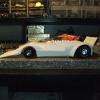I hope I will step on no one's foot here, I was asked on a PM to intervene in this little conflict. Since we are all enthusiasts, passionate about our little racing cars and their motors, no need for conflicts, I will offer here some of my acquired knowledge about these motors and their mounting methods.
First, let set something clearly and hopefully once and for all times: Mabuchi calls this basic motor, the FT26 line. They exist in three configurations, all with the same blue metric wire that is near AWG # 31:
1/ FT26 is always an endbell-side driven motor. Most common, hundreds of thousands if not millions, were produced from 1967 through 1970.
2/ FT26D is always a can-side driven motor. Much less common.
3/ FT26DS is the dual shaft, marketed by Classic as the CM470. There are very few other companies that marketed dual-shaft FT26 motors.
From these stock and quite fast motors with average brakes, the rewinders had a ball, with a vast number of models from Champion, Mura, Dyna-Rewind, U-Go and a plethora of others. But ALL save for the Champion "617", use the poor-quality, easily melting stock Delrin endbell. A very poor choice of material. Champion had their own endbell made out of Cycolac plastic, that had a higher melting point and allowed for a 'hotter" specification. But regardless, the FT26 line was doomed as a "better" motor because by the time it came out, the smaller, lighter FT16 had received enough improvements to not only be faster, with better brakes, but also offer better handling due to its lower center of gravity. Hence, it was doomed, but still provided plenty of great racing for amateurs while it lasted. Once the Champion "517", a co-production between Japan and America, and the American-made Mura M1000, were issued in late 1967 and mid- 1968, the FT26 became an obsolete rock.
The armature blanks shown by John H are likely a Champion product, used first on their endbell-side driven "617" motor, and later used in that guise by Champion and Champion only, in later variations of the 617, used for Group 15. This lamination style used thinner plates than the ones made by Mabuchi. These armature blanks were made in Japan for Champion, but NOT by Mabuchi. Champion knew quickly that their "617" motor was a blind alley because it never evolved, just changing name over the yars to liquidate the huge number of parts produced in 1968.
Now for the mounting issue: yes, I called the mounting of the motor in the Classic "Competition Asp" crude, and for the reasons as pointed out: it IS crude, but effective and far stronger than mounting the motor from its endbell, only retained by tabs bent over it, which is equally crude and much more prone to failure such as the endbell parting ways with the rest of the motor, which in case the motor is used as structural member, caused some pretty spectacular accidents and even, on-track fires!
Classic had a design engineer (you will read his name on my "never ending" book), who was first, a machinist. Hence he devised the mounting holes for the short # 1 self-tapping screws exactly on center of the wider part of the magnet retaining tabs, die-cut then bent inward.
Hence, while the mounting holes were effectively, a tapered rectangle instead of a proper round hole, it worked well and I have never seen or heard of anyone having any issue with that. So Gene's mounting is perfectly adequate even with only two screws.
As far as which company made the bracket, I will have to check on the dozens of different brackets at the LASCM because I remember seeing such, but never really paid any attention to them or who made them.
As far as endbell-side brackets for the FT26 motors, the one that first comes to mind is the Castle, still easily found today. I am not sure that Russkit made one: the Castle appears to be a Russkit copy of their very popular FT16 bracket, with an enlarged center hole.Champion of course had their own of nickel plated brass, where the mounting screw holes are joining the center hole. And there are others by Cobra, Phaze III, Ferret, Pactra, Du-Bro...
To conclude, I will have a look in the drawers where Scott has accumulated hundreds of these brackets and let you know of what I find.
























